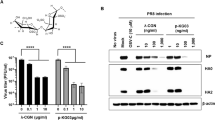Abstract
In this paper, in vitro anti-influenza virus activities of sulfated polysaccharide fractions from Gracilaria lemaneiformis were investigated. Cytotoxicities and antiviral activities of Gracilaria lemaneiformis polysaccharides (PGL), Gracilaria lemaneiformis polysaccharide fraction-1 (GL-1), Gracilaria lemaneiformis polysaccharide fraction-2 (GL-2) and Gracilaria lemaneiformis polysaccharide fraction-3 (GL-3) were studied by the Methyl thiazolyl tetrazolium (MTT) method, and the inhibitory effect against Human influenza virus H1-364 induced cytopathic effect (CPE) on MDCK cells were observed by the CPE method. In addition, the antiviral mechanism of PGL was explored by Plaque forming unit (PFU), MTT and CPE methods. The results showed: i) Cytotoxicities were not significantly revealed, and H1-364 induced CPE was also reduced treated with sulfated polysaccharide fractions from Gracilaria lemaneiformis; ii) Antiviral activities were associated with the mass percentage content of sulfate groups in polysaccharide fractions, which was about 13%, in polysaccharides (PGL and GL-2) both of which exhibited higher antiviral activity; iii) A potential antiviral mechanism to explain these observations is that viral adsorption and replication on host cells were inhibited by sulfated polysaccharides from Gracilaria lemaneiformis. In conclusion, Anti-influenza virus activities of sulfated polysaccharide fractions from Gracilaria lemaneiformis were revealed, and the antiviral activities were associated with content of sulfate groups in polysaccharide fractions.
Similar content being viewed by others
References
Andersson L O, Barrowcliffe T W, Holmer E, et al. 1979. Molecular weight dependency of the heparin potentiated inhibition of thrombin and activated factor X. Effect of heparin neutralization in plasma. Thromb Res, 15: 531–541.
Carlucci M J, Pujol C A, Ciancia M, et al. 1997. Antiherpetic and anticoagulant properties of carrageenans from the red seaweed Gigartina skottsbergii and their cyclized derivatives:correlation between structure and biological activity. Inter J Biol Macromol, 20: 97–105.
Chen M Z, Yu J, Long Z J, et al. 2005. Studies on antimutagenic and free radical scavenging effect of polysaccharide from Gracilaria lemaneiformis. Food Sci, 26(7): 219–222.
Craigie J S, Wen Z C, Vander Meer J P. 1984. Interspecific intraspecific and nutritionally determined variations in the composition of agars from Gracilaria spp. Bot Mar, 27: 55–61.
Carlucci M J, Ciancia M, Matulewicz M C, et al. 1999. Antiherpetic activity and mode of action of natural carrageenans of diversest ructural types. Antivir Res, 43: 93.
Duarte M E R, Cauduro J P, Noseda D G, et al. 2004. The structure of the agaran sulfate from Acanthophora spicifera (Rhodomelaceae, Ceramiales) and its antiviral activity. Relation between structure and antiviral activity in agarans. Carbohyd Res, 339: 335–347.
Deng Z F, Ji M H. 1995. Composition of polysaccharides of Gracilaria Sjeostedtii kylin and G.. Textorii (SUR.) De-Toni (Rhodophyta) and their antitumor effect. Oceanol Et Limnol Sin, 26(6): 575–581.
Dubois M, Gilles K A, Hamilton J K, et al. 1956. Colorimetric method for determination of sugars and related substances. Anal Chem, 28(3): 350–366.
Franz G, Pauper D, Alban S, et al. 2000. In: Bioactive Carbohydrate Polymers (Paulsen B S. ed), Dordrecht: Kluwer Academic Publishers, p47–58.
Gunay N S, Linhardt R J. 1999. Heparinoids: structure, biological activities and therapeutic applications. Planta Med, 65: 301–306.
Hsiung G D. 1994. Diagnostic Virology, 4th ed, New Haven: Yale University Press, 37–43.
Hill E L, Ellis M N, Nguyen D P. 1991. Antiviral and antiparasitic susceptibility testing. In: Manual of Clinical Microbiology (Balows A, Hausler W J, Jr. Herrmann, et al. ed.), 5th ed, Washinton DC 113: American Society for Microbiology, p1184–1191.
Haslin C, Lahaye M, Pellegrini M, et al. 2001. In vitro anti-HIV activity of sulfated cell wall polysaccharides from gametic, carposporic and tetrasporic stages of the Mediterranean red alga Asparagopsis armata. Planta Med, 67: 301–305.
Ivanova V, Rouseva R, Kolarova M, et al. 1994. Isolation of a polysaccharide with antiviral effect from Ulva lactuca. Preparative Biochem, 24: 83–97.
Jeffrey P K, James M H, James W, et al. 2000. Prevention and control of influenza. Morbidity and Mortality Weekly Report, 49(RR-3): 1–38.
Ji M H. 1997. Algal Chemistry, Beijing: Science Press, p90–96.
Kolender A A, Pujol C A, Damonte E B, et al. 1997. The system of sulfatedα-(1–3)-linked D-mannans from the red seaweed Nothogenia fastigiata: structures, antiherpetic and anticoagulant properties. Carbohyd Res, 304: 53–60.
Lee J B, Hayashi K, Hayashi T, et al. 1999. Antiviral activities against HSV-1, HCMV, and HIV-1 of rhamnan sulfate from Monostroma latissimum. Planta Med, 65: 439–441.
Lin X Z, Tang Y, Zhang Y M, et al. 2005. Composing and spectrum analysis of algal polysaccharides. Chemistry, (12): 911–917.
Luscher M M. 2000. Polyanions a lost chance in the fight against HIV and other virus diseases. Antivir Chem Chemother, 11: 249–259.
Mazumder S, Ghosal P K, Pujol C A, et al. 2002. Isolation, chemical investigation and antiviral activity of polysaccharides from Gracilaria corticata (Gracilariaceae, Rhodophyta). Inter J Biol Macromol, 31: 87–95.
Preeprame S, Hayashi K, Lee J B, et al. 2001. A novel antivirally active fucan sulfate derived from on edible brown alga, Sargassum horneri. Chem Pharm Bull, 49: 484–485.
Witvrouw M, De Clercq E. 1997. Sulfated polysaccharides extracted from sea algae as potential antiviral drugs. Gen Pharmacol, 29: 497–511.
Wang Z M, Li L, Guo S Y, et al. 2002. Progress in polysaccharide modification. Chin J Pharm, 33(12): 616–620.
Wang J T, Hu Q M, Zhang B S, et al. 1993. Organic Chemistry, Tianjin: Nankai University Press, p436–437.
Yu J, Wang X, Chen M Z, et al. 2006. Analysis on nutritional component and polysaccharide composition of Gracilaria lemaneiformis from Chaoshan coast. Food Sci, 26(1): 93–97.
Yoshida O, Nakashima H, Yoshida T, et al. 1998. Sulfation of the immunomodulating polysccharide lentinan: A noval strategy for antivirals to human immunodeficiency virus (HIV). Biochem Pharm, 37(7): 2887–2889.
Author information
Authors and Affiliations
Corresponding author
Additional information
Foundation items: The Science and Technology Projects of Guangdong (2009B020312012); The Science and Technology Projects of Shantou (2008-143).
Rights and permissions
About this article
Cite this article
Chen, Mz., Xie, Hg., Yang, Lw. et al. In vitro anti-influenza virus activities of sulfated polysaccharide fractions from Gracilaria lemaneiformis . Virol. Sin. 25, 341–351 (2010). https://doi.org/10.1007/s12250-010-3137-x
Received:
Accepted:
Published:
Issue Date:
DOI: https://doi.org/10.1007/s12250-010-3137-x




